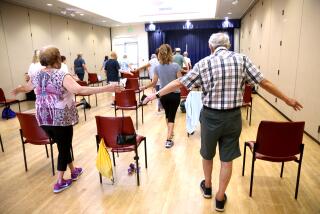Finding Wisdom in the Signs of Old Age
- Share via
Almost no one eagerly anticipates the prospect of growing old. It only seems like a good idea when compared with the alternative. In the fight against advancing years, whatever weapons we may choose--exercise, yoga, nutrition, a positive attitude, new friends and experiences, or face lifts and tummy tucks--we all hope to stay, or at very least to seem, as young as we can.
But perhaps, suggests Jungian psychologist and author James Hillman, there is another way to look at the process of getting older--indeed, a way to look beyond the limitations of our current youth-obsessed culture and learn how to understand and appreciate some of the very things we’re so afraid of. Taking a leaf from W.B. Yeats’ “Sacred Book of the Arts,” Hillman boldly attempts to illustrate the ways in which, as Yeats phrased it, “bodily decrepitude is wisdom.”
*
Hillman offers the startling, genuinely radical suggestion that various traits we associate with old age, such as desiccation, sagging muscles, lined faces, crankiness, sentimentality, confusion, repetition and loss of short-term memory, may be viewed as signs of character formation. Dryness, for example, can be seen as shedding the naive, gushing enthusiasms of youth (the state of being wet behind your ears) for the dry wit and wisdom of age: the salty residue that is left after the mushy liquid has boiled away. Facial lines show the imprint of character: the unique personal history that makes each person different. Repetition Hillman links to the retelling of important archetypal stories and myths by which the old transmit cultural heritage to succeeding generations. As for memory loss? An opportunity to let go of the bothersome details of daily life and concentrate instead on what Hillman calls “life review.”
“Character,” Hillman explains, “consolidates by commemorating moments of value in oneself.” The purpose of old age is to give people an opportunity to better understand their own character. Hillman has no use for the reductionist kind of biological thinking that postulates we are all put on Earth just to enable some “selfish gene” to reproduce itself. His view has more in common with the premise of George Bernard Shaw’s “Back to Methuselah”: The older one gets, the more one is able to develop one’s soul.
Lest this sound too much like self-realization therapy, Hillman points out that “character” in essence is ethical: It exists in our relation to other people and the rest of the world. “In later years,” he notes, “feelings of altruism and kindness to strangers play a larger role, as if psychological and cultural factors redirect, even override, genetic inheritance and its aim of propagation. . . . Values come under more scrutiny, and qualities such as decency and gratitude become more precious than accuracy and efficiency.”
Hillman writes suggestively rather than logically or descriptively: His aim is to shake up conventional ways of thinking and open new vistas. Some of his suggestions seem to contradict one another. In one chapter, we find him commending aged obstinacy, crankiness and ill-temper; in another, he praises mellowness, gentleness and sweetness as the ultimate glories of the wise old soul. Sometimes, his ideas sound like mere wishful thinking. And yet, as Hillman himself might say, wishful thinking can be a positive first step in the right direction.
*
Readers who may find some of Hillman’s notions a little hard to swallow may nonetheless find merit in other insights. Revaluing and recovering the lost or forgotten meanings of such honorable words as “old,” “last,” “leaving” and “left,” Hillman tries to get us out of the habit of thinking of old age as nothing more than a prelude to nonexistence: “What we value about things called old is precisely their deathless and ageless characters. Old masters’ paintings, old manuscripts, old gardens . . . do not bring to mind dying but everlastingness.” Before the Renaissance, he informs us, the term old (or “eald” in old English) was almost always used in a positive connection, connoting that which was trustworthy, venerable, well-loved.
Although most of us would hardly want to give up on the goal of staying healthy, it may indeed not be such a bad idea to become less fixated on being relentlessly “youthful” and “with it” in all we say and do. As Hillman notes, what can be said of a society that’s utterly obsessed with youthfulness yet blithely neglectful of the education and well-being of actual young people? The cult of youthfulness has certainly played some part in encouraging a general attitude of irresponsibility. Perhaps it’s time some of us started acting like grown-ups.
More to Read
Sign up for our Book Club newsletter
Get the latest news, events and more from the Los Angeles Times Book Club, and help us get L.A. reading and talking.
You may occasionally receive promotional content from the Los Angeles Times.










